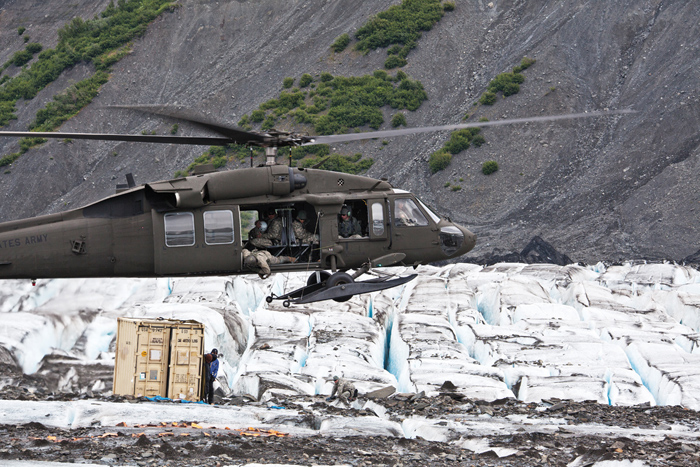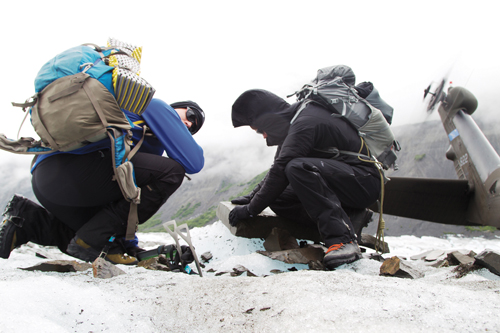Ned Rozell for UAFGI –
It’s not often that glaciologists help with the recovery of long-lost human remains, but military officials recently enlisted Martin Truffer for that purpose. The University of Alaska Fairbanks Geophysical Institute professor and graduate student Dave Podrasky came up with useful information on a Southcentral glacier that held plane wreckage and the remains of military men killed in a crash 60 years ago.
Colony Glacier, about 50 miles east of Anchorage, flows beneath the impact point of a military transport plane that crashed into 10,000-foot Mount Gannett in 1952. Because the accident site is so remote and rugged, no one had been able to recover the plane or the remains of its crew and passengers. Over time, Colony Glacier has churned the accident debris 14 miles downhill, close to the lake into which the glacier calves, Inner Lake George.

In June 2012, Army Air National Guard pilots flying over the glacier in a Blackhawk helicopter saw aircraft parts on the dirty, cracked-up ice. The wreckage was that of a massive C-124 cargo plane that went down on a flight from Tacoma to Elmendorf Air Force Base in November 1952. Forty-one passengers and 11 crewmembers died in the crash.
As the military planned a recovery mission, David Martin, a civilian who works with the Alaskan Command at Joint Base Elmendorf-Richardson, contacted Truffer, whom he met a few weeks earlier, with the question of when the glacier might deposit the plane debris into the glacial lake. Could they wait another summer, or was 2012 the best time for action?
Truffer asked Podrasky, a doctoral student specializing on Greenland glaciers, if he could determine how fast Colony Glacier flows. Podrasky found clear satellite images of Colony from the summers of 2001 and 2002. By identifying the same crevasses on the glacier and seeing how they moved in one year, Podrasky was able to come up with an answer.
“The crash site was just 500-meters-to-one-kilometer from the calving front,” said Podrasky, who produced a color-coded map of the glacier’s surface speed for the military team. “The glacier is flowing about 300-to-400 meters a year, so it seemed like they did need to go out and start retrieval this summer.”
The glaciologists also loaned the recovery team a drill with which to sink a rod deep in the surface of the glacier. By marking the rod with the level of the ice, the recovery groups could see how much glacier was melting near the crash debris.

“In that area, in a warm summer, you can have 30 feet of ice melt,” Truffer said. “You should expect that more stuff comes out as the ice melts.”
Alaskan Command staff contacted specialists with the Joint Prisoner of War/Missing in Action Accounting Command, based in Hawaii, whose job is to account for Americans lost during past U.S. conflicts. JPAC members teamed up with Alaska-based military personnel, as well as the Alaska National Guard, to recover human remains on the glacier. The JPAC team returned to Hawaii with the recovered bones and other possible human remains, which they are analyzing in a laboratory before notifying relatives of the dead.
Lt. Col. William Nall of Elmendorf-Richardson is part of a team that used the drill loaned by GI researchers. His group is still recovering pieces of the giant aircraft from Colony Glacier and expects to travel to the glacier again in September.
Nall said the information from the GI glaciologists was useful to the recovery team. Podrasky’s map revealed that this summer was the best time to get on the glacier, and those on the glacier felt better knowing it crept just a few feet each day and wouldn’t swallow them up while they worked.
“All of the information (Truffer and Podrasky) were able to get to us was key,” Nall said.
.
Find much more on arctic science at Frontier Scientists
Posted at University of Alaska Fairbanks News: Headlines by Ned Rozell on August 30 2012 http://www.uafnews.com/headlines/glaciologists-help-with-recovery-of-human-remains
Since the late 1970s, the University of Alaska Fairbanks’ Geophysical Institute has provided this column free in cooperation with the UAF research community. Ned Rozell is a science writer for the Geophysical Institute.